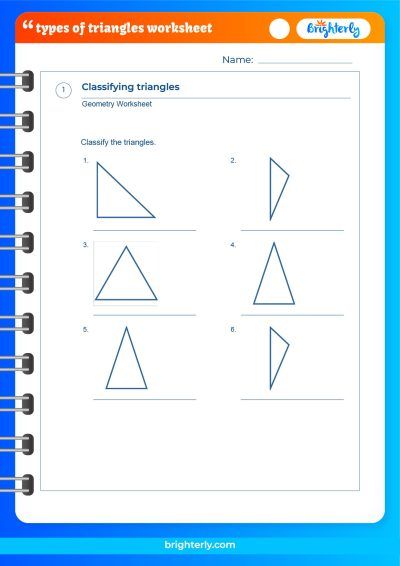Types of Triangles – Definition With Examples
Created on Dec 22, 2023
Updated on January 11, 2024
Welcome to Brighterly! In today’s exciting adventure, we will explore the captivating realm of triangles. As we delve into the various types of triangles, their unique properties, and classifications, you’ll discover just how essential these three-sided polygons are in mathematics, science, and engineering. So, buckle up and join us on this thrilling journey through the wonderful world of triangles!
What are the Different Types of Triangles?
Triangles are intriguing three-sided polygons that come in various shapes and sizes. With three vertices and three angles, these geometric wonders can be classified based on their sides, angles, or even a combination of both. In this Brighterly article, we will dive deep into the diverse world of triangles, unraveling their unique classifications and types that make them so fascinating.
To deepen your understanding of the concept of Types of Triangles, we recommend exploring the collection of math worksheets offered by Brighterly. These worksheets have been tailored to aid in learning and strengthening your comprehension of this topic.
Types of Triangles Based on Sides
When examining triangles through the lens of their side lengths, we discover three distinct types that emerge:
- Scalene Triangles
- Isosceles Triangles
- Equilateral Triangles
Each of these categories unveils a fresh perspective on the wonderful world of triangles, showcasing the diversity and beauty that can be found in these seemingly simple shapes.
Types of Triangles Based on Angles
If we shift our focus from side lengths to the size of interior angles, we’ll find that triangles can also be classified into three captivating categories:
- Acute Triangles
- Right Triangles
- Obtuse Triangles
By exploring these angle-based classifications, we unlock new insights into the intricate relationships that exist within these versatile polygons, further enriching our understanding of the awe-inspiring realm of triangles.
Types of Triangle Based on Sides and Angles
Here’s a table showing the different types of triangles based on both sides and angles:
| Side Classification | Angle Classification | Triangle Type |
|---|---|---|
| Scalene | Acute | Acute Scalene |
| Scalene | Right | Right Scalene |
| Scalene | Obtuse | Obtuse Scalene |
| Isosceles | Acute | Acute Isosceles |
| Isosceles | Right | Right Isosceles |
| Isosceles | Obtuse | Obtuse Isosceles |
| Equilateral | Acute | Equiangular |
Classification of Triangles Based on Side Lengths
Scalene Triangles
A scalene triangle is a triangle with all three sides of different lengths. Since none of the sides are equal, all three angles are also different. Scalene triangles can have acute, right, or obtuse angles.
Isosceles Triangles
An isosceles triangle has at least two sides of equal length. These equal sides are called the legs, and the third side is called the base. The angles opposite the equal sides, called the base angles, are also equal. Isosceles triangles can have acute, right, or obtuse angles as well.
Equilateral Triangles
An equilateral triangle has three equal sides and three equal angles. All angles in an equilateral triangle are 60 degrees, making it an equiangular triangle.
Classification of Triangles Based on Interior Angles
Acute Triangles
An acute triangle is a triangle where all three interior angles are less than 90 degrees. An acute triangle can be scalene, isosceles, or equilateral.
Right Triangles
A right triangle is a triangle with one interior angle measuring exactly 90 degrees. The side opposite the right angle is called the hypotenuse, and the other two sides are called the legs. A right triangle can be scalene or isosceles.
Obtuse Triangles
An obtuse triangle is a triangle with one interior angle greater than 90 degrees. Obtuse triangles can be scalene or isosceles.
Examples on Types of Triangles
Here are some examples of different types of triangles:
- An acute scalene triangle with sides measuring 5, 6, and 7 units.
- A right isosceles triangle with legs measuring 3 units and a hypotenuse of 3√2 units. 3. An obtuse scalene triangle with sides measuring 3, 7, and 8 units.
- An acute isosceles triangle with equal sides measuring 5 units and a base of 4 units.
- An equilateral triangle with sides measuring 6 units.
Practice Questions on Types of Triangles
Now that you have learned about the different types of triangles, try to solve these practice questions to test your understanding:
- Identify the type of triangle with sides measuring 8, 15, and 17 units.
- Determine the type of triangle with angles measuring 30, 60, and 90 degrees.
- Classify the triangle with angles measuring 100, 30, and 50 degrees and sides measuring 4, 4, and 6 units.
Conclusion
Congratulations on completing this amazing voyage through the diverse landscape of triangles with Brighterly! You’ve now gained valuable knowledge about the various types of triangles and their classifications based on sides, angles, or both. Equipped with this newfound understanding, you’ll find it easier to tackle geometry problems and apply these concepts in a myriad of mathematical, scientific, and engineering situations.
But don’t stop here! Continue to practice and expand your horizons as you explore even more fascinating aspects of triangles and other geometric shapes. At Brighterly, we’re committed to helping you shine brighter and reach greater heights in your learning journey. Stay curious, keep discovering, and remember—learning is a never-ending adventure!
Frequently Asked Questions on Types of Triangles
Can a triangle have more than one right angle?
No, a triangle cannot have more than one right angle. The reason behind this is simple: the sum of the interior angles of any triangle always adds up to 180 degrees. If a triangle were to have two right angles, the sum of these two angles alone would be 180 degrees (90 + 90), leaving no room for the third angle, which contradicts the definition of a triangle. Thus, a triangle can only have one right angle at most.
Can an obtuse triangle be equilateral?
No, an obtuse triangle cannot be equilateral. An obtuse triangle is defined as a triangle with one interior angle greater than 90 degrees. In contrast, an equilateral triangle has all angles equal to 60 degrees, which are acute angles. Since the angle measures of an equilateral triangle do not meet the criteria for an obtuse triangle, the two classifications are mutually exclusive.
Can a right triangle be equilateral?
No, a right triangle cannot be equilateral. A right triangle has one angle equal to 90 degrees, which is a defining characteristic of this type of triangle. An equilateral triangle, on the other hand, has all sides equal in length and all angles equal to 60 degrees. Since the angle measures of an equilateral triangle do not match the requirements for a right triangle, it is impossible for a triangle to be both right and equilateral.
What is the sum of the angles of a triangle?
The sum of the interior angles of a triangle is always 180 degrees. This fundamental property of triangles is derived from the fact that the sum of the angles in any polygon can be calculated as (n – 2) × 180 degrees, where n is the number of sides. For a triangle, n equals 3, so the sum of its angles is (3 – 2) × 180 = 180 degrees. This rule applies to all types of triangles, regardless of their side lengths or angle measures.
Information Sources
Information for this article was gathered from the following sources:






